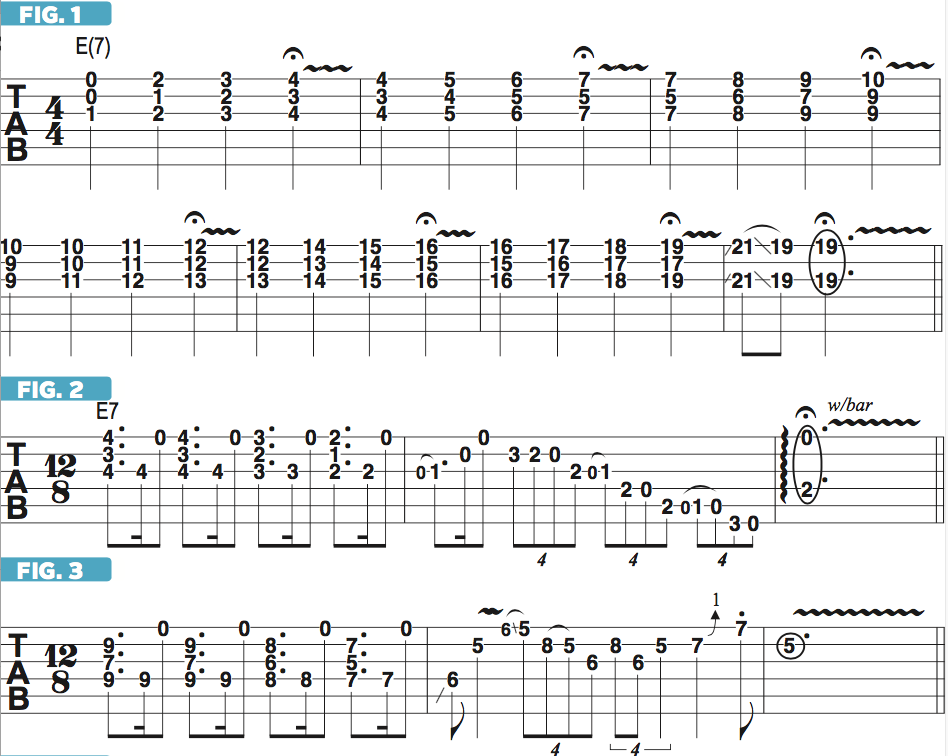Make your blues solos awesome using dominant seven chords
Many blues songs are built around major-key progressions based on this shape
Many blues songs are built around major-key chord progressions based on dominant seven chords. A dominant seven chord has a root note (1), a major third (3), a perfect fifth (5) and a minor, or “flatted” seventh (b7). For example, if the root note is E, the remaining chord tones would be G# (the 3), B (the 5) and D (the b7); when played together, these four notes sound an E7 chord. A great way to add dimension to a solo is to play a melodic line that outlines a series of dominant seven chords, wherein the melody, as the highest note, is harmonized by additional notes below it, derived from dominant seven chord shapes. This technique is well served by the use of chromatic movement between the dominant seven voicings, whereby they shift up or down in half steps, one fret at a time.
In FIGURE 1, an E major triad (voiced G# B E, or 3-5-1) is sounded at the beginning of bar 1. In order to connect this triadic voicing to the E7 voicing on beat four, we move up in consecutive half steps from D7, on beat two, to Eb7, on beat three, to E7 on beat four. This technique is then repeated in bar 2, where we move from a third-position voicing of E7 to the fifth-position shape. In bar 3, we move from that voicing up to a ninth-position E7, and in bar 4 we move from there up to a 12th-position E major triad, replicating our first chord shape 12 frets and one octave higher. Bars 5 and 6 utilize the same shapes from bars 1 and 2, played 12 frets higher. The figure ends with sliding sixths on the G and high E strings.
No let’s apply the concept to a musical idea. In FIGURE 2, an E7 chord shape is played on the top three strings in a fingerpicked, arpeggiated manner, with the addition of the open high E string. This shape then moves down chromatically to a first-position E major triad and a single-note phrase based on the E blues scale (E G A Bb B D).

We can voice this type of melodic/chordal idea higher on the fretboard by moving the shapes over to the D, G and B strings, as shown in FIGURE 3. The dominant-seven chord shapes descend chromatically in bar 1, and the phrase rounds out in bar 2 with another E blues-scale lick, played in this position.
In FIGURE 4, the concept is moved over to the A, D and G strings, wrapping up with bluesy single-notes licks played in ninth position. FIGURE 5 exploits the chromatic approach further. Beginning in 16th position, we steadily move down the neck chromatically across four bars, landing in first position and culminating with a flashy, pull-off/slide lick based on the E blues scale.

Try devising more ascending/descending chromatic phrases using these approaches.
All the latest guitar news, interviews, lessons, reviews, deals and more, direct to your inbox!
Guitar World Associate Editor Andy Aledort is recognized worldwide for his vast contributions to guitar instruction, via his many best-selling instructional DVDs, transcription books and online lessons. Andy is a regular contributor to Guitar World and Truefire, and has toured with Dickey Betts of the Allman Brothers, as well as participating in several Jimi Hendrix Tribute Tours.

